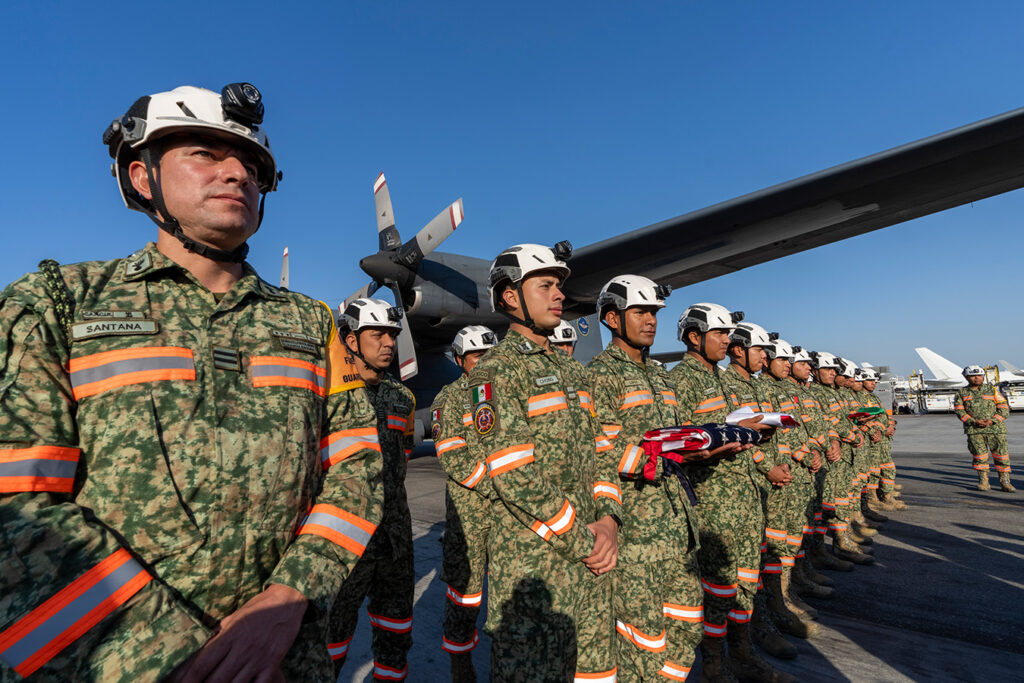A mutual aid agreement between Mexico and the United States has come in handy so far in 2025. Dozens of Mexican firefighters responded to the Los Angeles fires in January, and U.S. firefighters helped douse flames near Tijuana in June. Above, Mexican firefighters arrive in California to help fight wildfires on January 11, 2025. CALIFORNIA GOVERNOR’S OFFICE
A little-known aspect of the bilateral cooperation that occurs along the 3,145-kilometer-long border between Mexico and the United States is a formal commitment to help one another during natural disasters. A bilateral mutual aid agreement, dating back more than two decades, allows the neighboring countries to provide crucial assistance during an emergency, a principle put into practice during recent wildfires on both sides of the frontier.
When the Guadalajara 2 Complex fire threatened the communities of Campo and Jacumba in California in June 2025, U.S. firefighters worked with their Mexican counterparts to suppress several fires burning out of control in a mountainous area east of Tijuana. “Baja California was resource deficient because they had multiple fires burning in the region,” Cal Fire Battalion Chief John Clark told Border Report, a U.S. news site focused on border issues. Cal Fire responded with two hand crews and one fire bulldozer to stamp out the fire on the U.S. side. The U.S. crews entered Mexico through the Tecate Port of Entry and began coordinating with their counterparts in Baja. “We were able to use a minimum amount of resources to mitigate the issue on the Mexican side so it did not grow into a larger fire and cause more risk to residents of California,” Clark said.
In January, when raging wildfires devastated large parts of Los Angeles and southern California, Mexico responded with fire suppression assistance. More than 70 firefighters and disaster relief workers from the National Forestry Commission and Ministry of Defense in Mexico arrived to help form hand crews, assist local law enforcement, transportation and California National Guard operations, according to a January news release from California Gov. Gavin Newsom’s office. “Emergencies have no borders – we are deeply grateful to our neighbors in Mexico for their unwavering support during one of our greatest times of need. Thank you to President Claudia Sheinbaum for lending the best of the best,” Newsom said in the statement. Sheinbaum responded that offering help was the Mexican way. “We are a generous and supportive country,” Sheinbaum wrote on X of the deployment. “You carry with you the courage and heart of Mexico.”
Mexico and the U.S. have conducted joint disaster relief training for decades. In a June 2024 simulation, parts of Juarez, Mexico, filled with smoke and 30 mock victims lying on the streets as Mexican authorities requested cross-border assistance from the U.S. to help contain a chemical fire from parked tank cars on a rail line connecting Juarez to El Paso, Texas. The annual exercise demonstrated the increasing compatibility of Mexican and U.S. forces and the practical benefits of mutual aid in cross-border disasters. The exercise, which involved 220 U.S. Soldiers, was held for the first time outside a Mexican or U.S. military base.
The 1999 treaty regulating cross-border fire assistance also provides for training and equipment exchanges. U.S. Northern Command’s mission includes coordinating any federal response to disasters.

